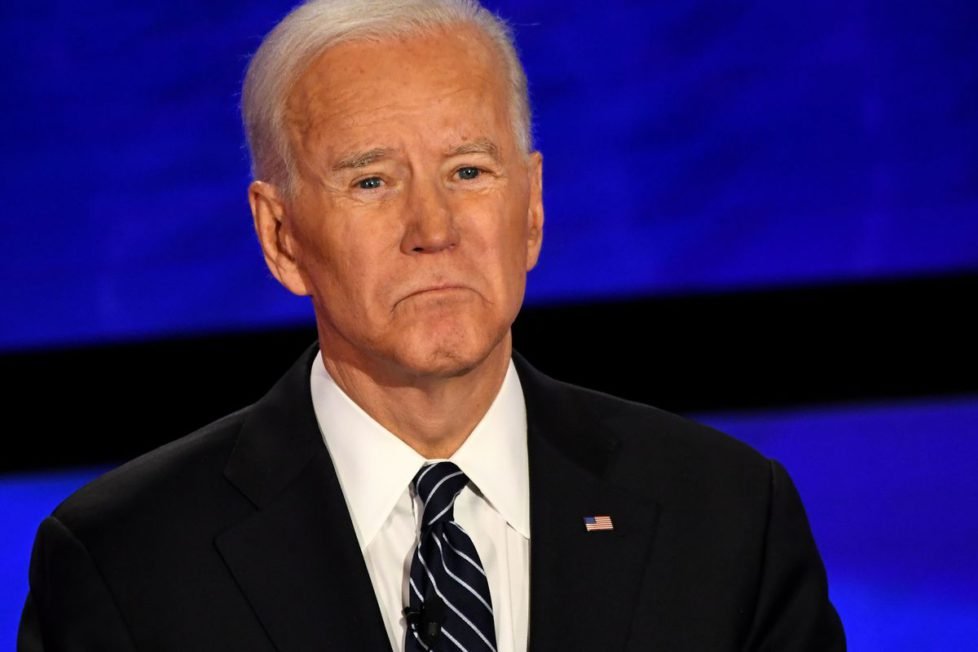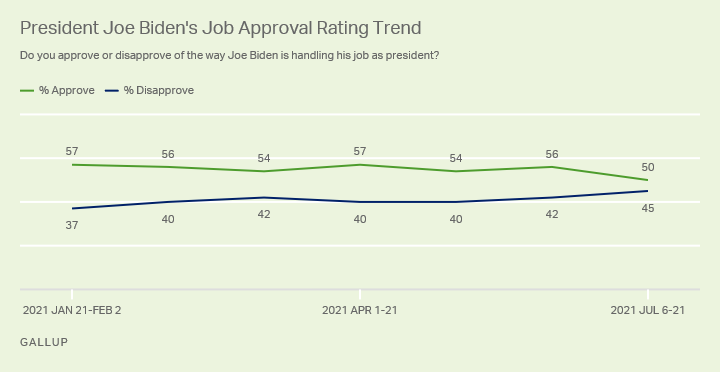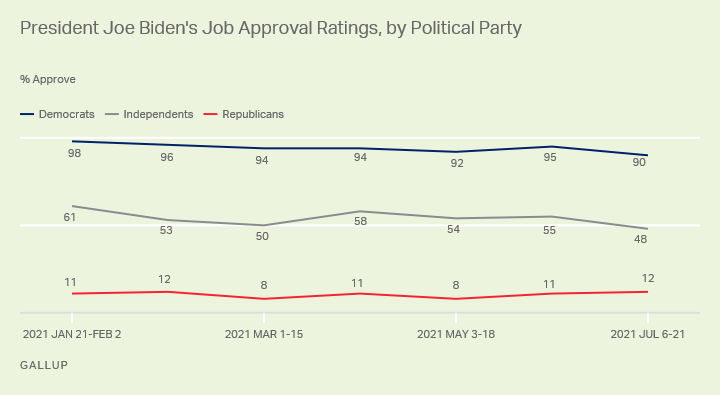Biden Approval Drops lowest ever — at 50% currently.
Biden Approval Drops to 50%, Lowest for Him to Date.

Biden Approval Drops to 50%, Lowest for Him to Date.

WASHINGTON, D.C. — President Joe Biden’s latest job approval rating of 50% is down from 56% in June. Before this month, his ratings had not shown meaningful variation during his time in office, and the current figure marks the lowest measured for him to date.

The new rating is from a July 6-21 Gallup poll, which also finds that 45% of U.S. adults disapprove of Biden’s performance and 5% do not have an opinion. It comes at a time when U.S. progress in fighting the coronavirus has stalled, with vaccination rates slowing and case levels now rising. The economic recovery continues, with unemployment declining and stock market values near record highs. But consumers are paying higher prices for gas and other goods. Biden has also struggled to deliver on his promise of greater bipartisanship, although negotiations on an infrastructure bill continue in the Senate.
Biden’s approval ratings are marked by extreme party polarization, which has become the norm for presidential approval in recent years. Currently, 90% of Democrats, 12% of Republicans and 48% of independents approve of the job Biden is doing. His ratings among Democrats and independents are the lowest to date among those groups. The new poll marks the first time he has less-than majority approval among independents.

Line graph. President Joe Biden’s job approval ratings by political party. Currently, 90% of Democrats, 48% of independents and 12% of Republicans approve of the job Biden is doing. His approval rating has not fallen below 90% among Democrats or exceeded 12% among Republicans. His approval rating among independents has ranged from 48% to 61%.
Biden just concluded his second quarter in office, extending from April 20 through July 19. During this three-month period, Biden averaged 53.3% job approval, down slightly from the 56.0% average during his first quarter.
Biden’s second-quarter average compares favorably with those of presidents from the past three decades. It is significantly better than the second-quarter averages for Bill Clinton (44.0%) and Donald Trump (38.8%) and slightly lower than George W. Bush’s 55.8% average. Barack Obama, at 62.0%, is the only other president during this period to have a significantly higher second-quarter average than Biden.
Presidents who served in the 1950s through the 1980s — when party ratings of presidents were far less polarized — had higher averages, with none below 61%. This includes Dwight Eisenhower and John Kennedy, who averaged better than 70% job approval during their second quarters.Second-Quarter Job Approval Averages of Presidents Elected to Their First Term
| Dates | Average job approval | Number of polls | |
|---|---|---|---|
| % | |||
| Eisenhower | Apr 20-Jul 19, 1953 | 71.5 | 2 |
| Kennedy | Apr 20-Jul 19, 1961 | 76.2 | 5 |
| Nixon | Apr 20-Jul 19, 1969 | 62.0 | 5 |
| Carter | Apr 20-Jul 19, 1977 | 63.5 | 6 |
| Reagan | Apr 20-Jul 19, 1981 | 60.8 | 5 |
| G.H.W. Bush | Apr 20-Jul 19, 1989 | 63.8 | 4 |
| Clinton | Apr 20-Jul 19, 1993 | 44.0 | 8 |
| G.W. Bush | Apr 20-Jul 19, 2001 | 55.8 | 9 |
| Obama | Apr20-Jul 19, 2009 | 62.0 | 89 |
| Trump | Apr 20-Jul 19, 2017 | 38.8 | 88 |
| Biden | Apr 20-Jul 19, 2021 | 53.3 | 3 |
| GALLUP |
The roughly three-percentage-point drop in Biden’s average approval rating between his first and second quarters is typical for recent presidents. It essentially matches the change for Trump and George W. Bush, and is slightly more than the one-point decline in Obama’s average. Clinton’s approval rating declined nearly 11 points between his first and second quarters.
Average approval for presidents before Clinton mostly held steady between their first and second quarters. The two major exceptions are Carter, whose average approval declined nearly six points, and George H.W. Bush, whose average increased nearly seven points.
Looking ahead, presidential approval ratings have been more likely to decline rather than increase during presidents’ third quarters in office. Obama had the largest drop, of nearly 10 points, as unemployment climbed and his push for healthcare reform proved controversial. Other presidents had drops of two to four points, including Eisenhower, Nixon, Carter, Reagan and Trump.
There have been exceptions, though, as George H.W. Bush (+5 points) and George W. Bush (+16 points) saw their ratings rise amid rallies related to the easing of the Cold War and the 9/11 terrorist attacks, respectively. Clinton’s approval rating started to show improvement (nearly four points higher) after his unusually low second-quarter average, while Kennedy’s was largely unchanged.
Biden’s approval rating is showing the first signs of meaningful decline. If the lower ratings persist, it could indicate his “honeymoon” period is over. Because Republicans have been unlikely to support him from the beginning of his presidency, changes in his approval are likely to come from Democrats’ and independents’ evaluations of him. That is what has occurred now, with both groups slightly less positive toward Biden than they have been to this point. Still, he maintains very high approval among Democrats, and his rating among independents remains higher than his immediate predecessor Trump ever received from that group.
Author & Source: JEFFREY M. JONES, https://news.gallup.com/poll/352733/biden-approval-drops-lowest-date.aspx?utm_source=alert&utm_medium=email&utm_content=morelink&utm_campaign=syndication
Image: The Verge
DISCLAIMER: The author is solely responsible for the views expressed in this article. The author carries the responsibility for citing and/or licensing of images utilized within the text.
